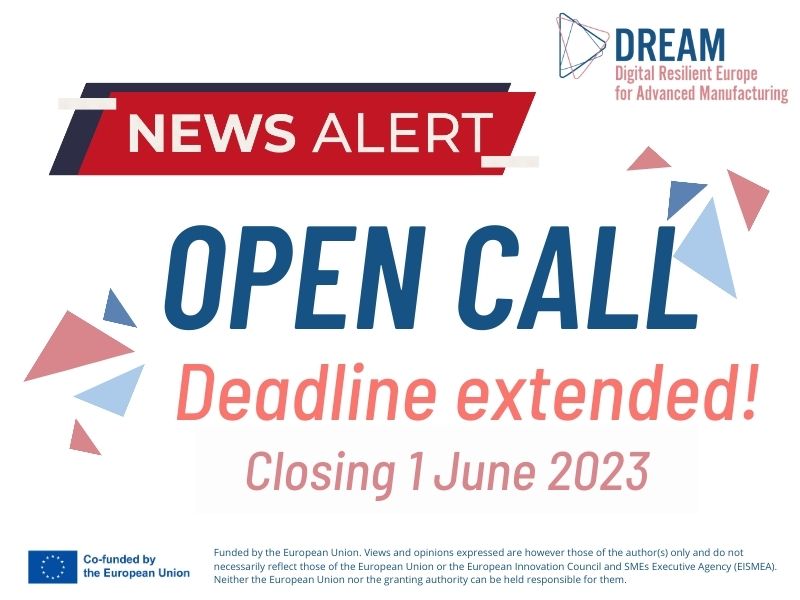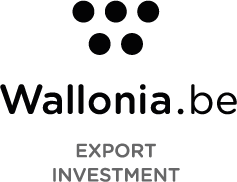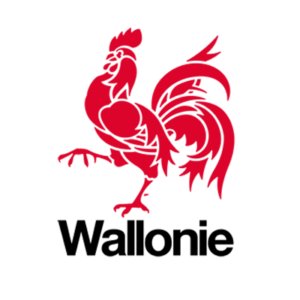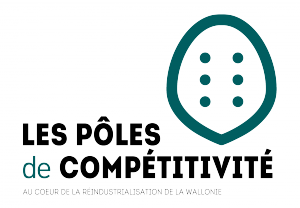
Under this Open Call, DREAM will select up to 35 collaborative projects. The total budget for the DREAM Open Call is 1.050.000 €.
The general objective of the DREAM Open Call is to financially support small and market-oriented projects involving SMEs, consisting of the integration and the use of digital technologies into manufacturing environments. DREAM Financial Support will be allocated to collaborative consortium applying to the DREAM Open Call, and demonstrating how the implementation of innovative digital technologies support the green transition of manufacturing processes, especially concerning the improved and more efficient use of resources (energy, water, supplies, materials). It also seeks to accelerate the access to the market to new digital products and services provided by technology SMEs, applied to the manufacturing domain strengthening innovation and growth in Europe.
The consortium composition must be composed of at least 2 partners:
- Partner 1 = SME from digital sector
- Partner 2 = Private entity from industrial sector
Applicants must be legal entities located in one of the participating countries in the Single Market Programme (SMP), namely:
- EU Member States (including overseas countries and territories (OCTs));
- Non-EU countries: listed European Economic Area EEA countries and countries associated to the COSME part of the Single Market Programme (list of participating countries).
At least one legal entity of the consortium (digital SME or end-user) must be based in a country of one of the DREAM consortium partners, i.e. France, Italy, Belgium or Romania.
The consortium shall gather entities from at least two different NUTS 1 regions of Europe from eligible countries. Applicants from Central and Eastern Europe (EU-13) are encouraged to apply.
All entities applying as one consortium should be autonomous to one another (without capital or personal links).
The maximum funding per project is 30.000 € under the form of a grant lump-sum. Only SMEs are eligible to receive funding.
The DREAM Open Call will provide financial support to two different types of actions, namely:
- Prototyping action will target companies having already carried out a feasibility study, and having the need to develop a prototype, to spend efforts in miniaturisation, testing, experimentation, MVP building, etc. (TRL 6).
- Demonstration action will target companies having already developed and tested a prototype, with the need to demonstrate its efficiency on a larger scale, in real environment (TRL 7-8).
The expected technologies in the DREAM Open Call are digital technologies that can contribute to the sustainability challenge and the resilience of processes:
- Artificial intelligence, Big Data and analytics
- Internet of Things (IoT)
- Cloud Computing
- Autonomous Robotics
- Immersive technologies (AR/VR)
- Simulation
- System Integration
- Cybersecurity
The expected industrial sectors addressed in the DREAM Open Call are manufacturing industries, including electronics, nanotechnologies, automotive, mechanicals, aerospace, medical & pharmaceutical, construction, energy & utilities, marine (naval industries), metal working, chemicals, food & beverage, logistics, printing, textile, luxury, cosmetics, wood, paper, furniture, consumer products, etc.
Open Call Submission process
Applications to the DREAM Open Call shall be submitted exclusively to the following dedicated web address
Applicants have to firstly create an account on the aforementioned website. Then, after registration, a dedicated form will appear where all the required information for the application has to be entered as text box or dropped down menu or similar. Some additional documents in pdf have to be attached (letter of support if any, results of self-financial viability check and SME self-assessment).
Evaluation process
At least two independent experts will evaluate independently each proposal according to the following criteria:
1. Excellence, 2. Impact, 3. Implementation.
A score from 1 to 5 including half scores will be assigned to each of the 3 criteria. The threshold for each criteria will be 3 points. The overall threshold, applying to the sum of the three individual scores, will be 10 points. For each application above the threshold, a bonus point will be given the applications in which the 2 participating entities are from 2 different countries (transnational bonus point).
The project is coordinated by Pôle SCS, and includes Pôle MecaTech, G.A.C Group and MESAP, all already partners in IoT4Industry project (2018-2020). The project represents an opportunity to make exploitable and sustainable the collaboration and the experiences started in 2018, bringing the synergies beyond by including the Romanian cluster of Cluj IT focused in information technology field.


